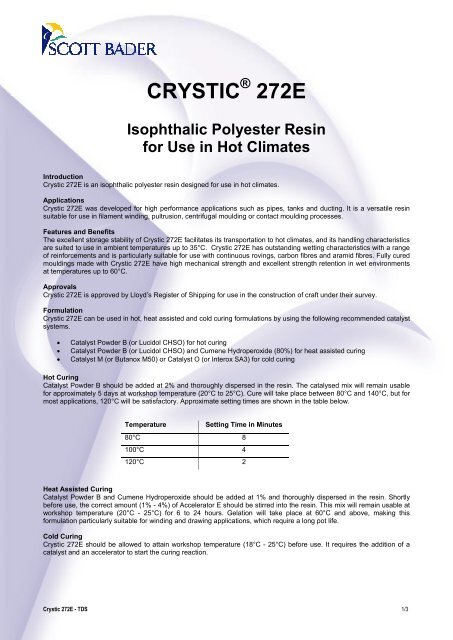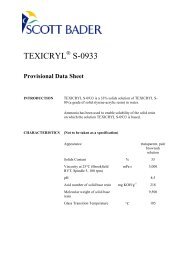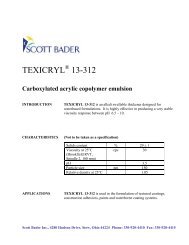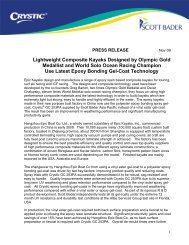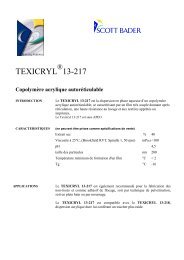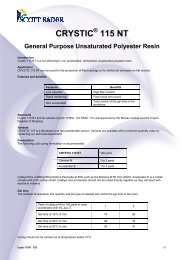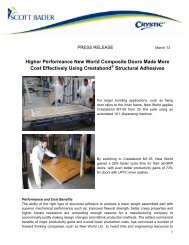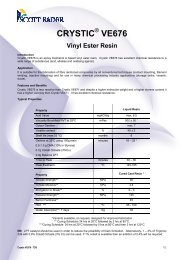Crystic 272E Resin - English - Scott Bader
Crystic 272E Resin - English - Scott Bader
Crystic 272E Resin - English - Scott Bader
You also want an ePaper? Increase the reach of your titles
YUMPU automatically turns print PDFs into web optimized ePapers that Google loves.
CRYSTIC ® <strong>272E</strong><br />
Isophthalic Polyester <strong>Resin</strong><br />
for Use in Hot Climates<br />
Introduction<br />
<strong>Crystic</strong> <strong>272E</strong> is an isophthalic polyester resin designed for use in hot climates.<br />
Applications<br />
<strong>Crystic</strong> <strong>272E</strong> was developed for high performance applications such as pipes, tanks and ducting. It is a versatile resin<br />
suitable for use in filament winding, pultrusion, centrifugal moulding or contact moulding processes.<br />
Features and Benefits<br />
The excellent storage stability of <strong>Crystic</strong> <strong>272E</strong> facilitates its transportation to hot climates, and its handling characteristics<br />
are suited to use in ambient temperatures up to 35°C. <strong>Crystic</strong> <strong>272E</strong> has outstanding wetting characteristics with a range<br />
of reinforcements and is particularly suitable for use with continuous rovings, carbon fibres and aramid fibres. Fully cured<br />
mouldings made with <strong>Crystic</strong> <strong>272E</strong> have high mechanical strength and excellent strength retention in wet environments<br />
at temperatures up to 60°C.<br />
Approvals<br />
<strong>Crystic</strong> <strong>272E</strong> is approved by Lloyd’s Register of Shipping for use in the construction of craft under their survey.<br />
Formulation<br />
<strong>Crystic</strong> <strong>272E</strong> can be used in hot, heat assisted and cold curing formulations by using the following recommended catalyst<br />
systems.<br />
• Catalyst Powder B (or Lucidol CHSO) for hot curing<br />
• Catalyst Powder B (or Lucidol CHSO) and Cumene Hydroperoxide (80%) for heat assisted curing<br />
• Catalyst M (or Butanox M50) or Catalyst O (or Interox SA3) for cold curing<br />
Hot Curing<br />
Catalyst Powder B should be added at 2% and thoroughly dispersed in the resin. The catalysed mix will remain usable<br />
for approximately 5 days at workshop temperature (20°C to 25°C). Cure will take place between 80°C and 140°C, but for<br />
most applications, 120°C will be satisfactory. Approximate setting times are shown in the table below.<br />
Temperature<br />
Setting Time in Minutes<br />
80°C 8<br />
100°C 4<br />
120°C 2<br />
Heat Assisted Curing<br />
Catalyst Powder B and Cumene Hydroperoxide should be added at 1% and thoroughly dispersed in the resin. Shortly<br />
before use, the correct amount (1% - 4%) of Accelerator E should be stirred into the resin. This mix will remain usable at<br />
workshop temperature (20°C - 25°C) for 6 to 24 hours. Gelation will take place at 60°C and above, making this<br />
formulation particularly suitable for winding and drawing applications, which require a long pot life.<br />
Cold Curing<br />
Crystìc <strong>272E</strong> should be allowed to attain workshop temperature (18°C - 25°C) before use. It requires the addition of a<br />
catalyst and an accelerator to start the curing reaction.<br />
<strong>Crystic</strong> <strong>272E</strong> - TDS 1/3
The recommended accelerator is Accelerator E which must be thoroughly dispersed in the resin. This mix will remain<br />
usable for approximately one month at ambient temperature (25°C). Shortly before use, the catalyst should be added.<br />
The recommended catalyst is Catalyst M (or Butanox M50) which should be added at 2% into the accelerated resin mix,<br />
and thoroughly dispersed. For low taint applications, the catalyst should be Catalyst O (or Interox LA3), also at a 2%<br />
addition. It should be noted that resin which has been accelerated for several days may have a shorter pot life than<br />
freshly accelerated resin.<br />
N.B. Catalyst and accelerator must not be mixed directly together as they can react with explosive violence.<br />
Pot Life The amount of Accelerator E can be approximately determined from the table below.<br />
Parts of Accelerator E to 100 Parts<br />
<strong>Resin</strong>. Catalysed with 2% Catalyst M<br />
1.0 2.0 3.0 4.0<br />
Pot life in Minutes at 20°C 48 34 27 22<br />
Pot life in Minutes at 25°C 36 25 21 18<br />
Pot life in Minutes at 30°C 24 20 17 15<br />
The resin and the workshop should be at, or above, 20°C before curing is carried out.<br />
Additives<br />
<strong>Crystic</strong> <strong>272E</strong> may be pigmented by the addition of up to 5% <strong>Crystic</strong> Pigment Paste. The addition of certain pigments,<br />
ñllers or extra styrene may adversely affect the food taint, toxicity and chemical resistant properties of <strong>Crystic</strong> <strong>272E</strong>.<br />
Customers should therefore satisfy themselves that any additions made Will give the performance required.<br />
Chemical Resistance<br />
A useful guide to the chemical resistance of <strong>Crystic</strong> <strong>272E</strong> laminates in over 200 chemical environments can be obtained<br />
by referring to <strong>Crystic</strong> 272 in the current edition of Technical Leaflet 145.3 - Safe Chemical Containment.<br />
Typical Properties<br />
The following tables give typical properties of <strong>Crystic</strong> <strong>272E</strong> when tested in accordance with BS 2782.<br />
Property<br />
Appearance<br />
Liquid <strong>Resin</strong><br />
Yellowish<br />
Viscosity at 25°C 37.35 sec -1 poise 3.5<br />
Specific Gravity at 25°C 1.10<br />
Volatile Content % 40<br />
Acid Value Mg KOH/g 18<br />
Stability at 20°C 6<br />
Geltime at 25°C using 2% Catalyst M (Butanox<br />
M50) and 4% Accelerator E<br />
Property<br />
Minutes 18<br />
Fully *Cured <strong>Resin</strong><br />
(unfilled casting)<br />
Barcol Hardness (Model GYZJ 934-1) 44<br />
Deflection Temperature under load † (1.80 MPa)<br />
ºC 78<br />
Water Absorption 24 hrs at 23ºC mg 18<br />
Tensile Strength MPa 79<br />
Tensile Modulus MPa 3400<br />
Elongation at Break % 4.5<br />
Specific Gravity at 25°C 1.2<br />
Volume Contraction % 8.3<br />
Refractive Index n 20 1.570<br />
*Curing schedule - 24 hrs at 20ºC, 3 hrs at 80ºC<br />
†Curing schedule - 24 hrs at 20ºC, 5 hrs at 80ºC, 3 hrs at 120ºC<br />
<strong>Crystic</strong> <strong>272E</strong> - TDS 2/3
Property<br />
CSM** Laminate<br />
Glass Content % 34<br />
Tensile Strength<br />
MPa 132<br />
Tensile Modulus MPa 8200<br />
Elongation at Break % 2.0<br />
Flexural Strength MPa 193<br />
Flexural Modulus MPa 6400<br />
** Made with 4 layers 450 g/m 2 PB CSM<br />
Curing schedule - 24 hrs 20°C 16 hrs 40°C<br />
Post Curing<br />
Satisfactory laminates for many applications can be made with <strong>Crystic</strong> <strong>272E</strong> by curing at workshop temperature (20°C).<br />
However, for optimum chemical, water and heat resistant properties, heat assisted and cold cured laminates must be<br />
post cured before being put into service. Mouldings should be allowed to cure for 24 hours at 20°C and then be oven<br />
cured for 3 hours at 80°C. Post curing is not normally necessary for heat cured laminates provided that the moulding<br />
cycle is adequate.<br />
For low taint applications, mouldings should be allowed to cure for 24 hours at 20°C and then be oven cured for 3 hours<br />
at 85°C. This should be followed by wet-steam cleaning for at least one hour. If the moulding is of a suitable shape, it can<br />
be filled with hot water (80°C) for two hours instead of steam cleaning. The water should contain a perfume detergent,<br />
and several batches of clean water should be used for rinsing.<br />
Storage<br />
<strong>Crystic</strong> <strong>272E</strong> should be stored in the dark in suitable closed containers. It is recommended that the storage temperature<br />
should be less than 20°C where practical, but should not exceed 30°C. Ideally, containers should be opened only<br />
immediately prior to use.<br />
Packaging<br />
<strong>Crystic</strong> <strong>272E</strong> is supplied in 225kg steel containers. For transportation purposes, <strong>Crystic</strong> <strong>272E</strong> is Class 3.3 in the IMCO<br />
code and UN No 1866; ADR No 3l (c). Packing Group 3; Tremcard No 30G35.<br />
Health and Safety<br />
Please see separate Materials Safety Data Sheet.<br />
Version 2 : February 2013<br />
All information on this data sheet is based on laboratory testing and is not intended for design purposes. <strong>Scott</strong> <strong>Bader</strong> makes no representations or warranties of any<br />
kind concerning this data. Due to variance of storage, handling and application of these materials, <strong>Scott</strong> <strong>Bader</strong> cannot accept liability for results obtained. The<br />
manufacture of materials is the subject of granted patents and patent applications; freedom to operate patented processes is not implied by this publication.<br />
SCOTT BADER COMPANY LIMITED<br />
Wollaston, Wellingborough, Northamptonshire, NN29 7RL<br />
Telephone: +44 (0) 1933 663100<br />
Facsimile: +44 (0) 1933 666623<br />
www.scottbader.com<br />
<strong>Crystic</strong> <strong>272E</strong> - TDS 3/3


